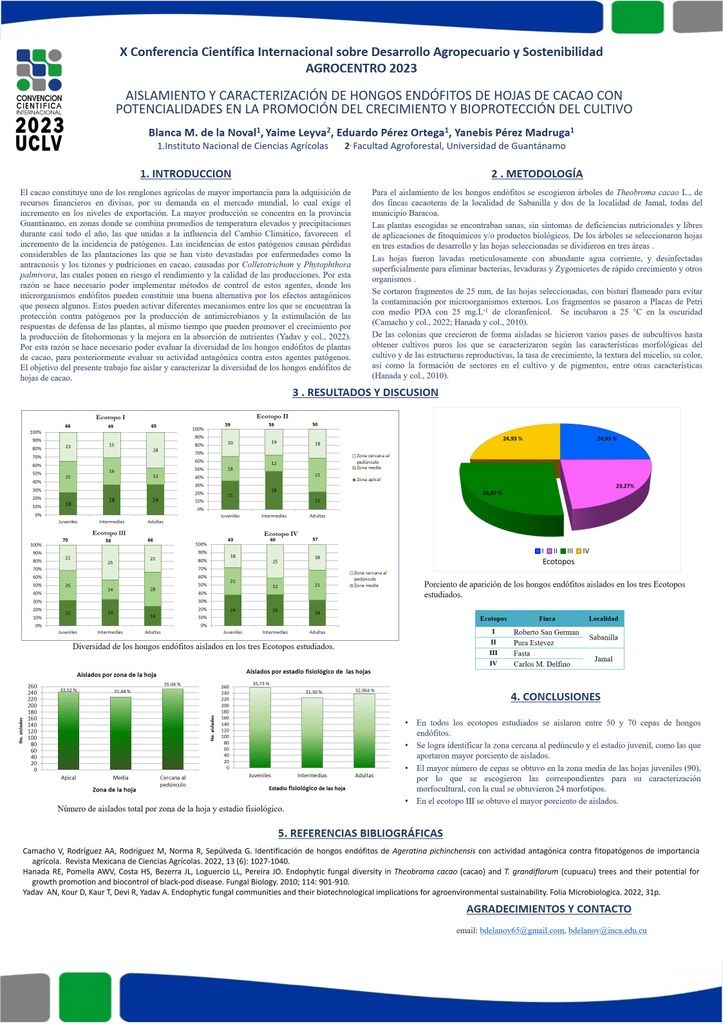Executive Secretary

9th International Scientific Conference on Agricultural Development and Sustainability
10th Symposium of Agronomy

Abstract
Cocoa constitutes one of the most important agricultural products due to its demand in the world market, which requires an increase in export levels. Its production is carried out with little, or no, availability of fertilizers or nutritional sources. For this reason, it is essential to have biological alternatives with potential for promoting growth and inducing defense mechanisms that enhance bioprotection effects against the most common pathogens such as endophytic fungi. With the objective of having strains of native cocoa endophytic fungi, with potential for use in crop management, isolation and characterization were carried out at sites in the towns of Sabanilla and Baracoa, in the province of Guantánamo, where identified 4 ecotopes. Sampling was carried out on leaves in three stages of development (juvenile, intermediate and adult), which were in turn divided into three zones of the leaf (close to the peduncle, middle and apical zone). A total of 722 isolates were obtained, belonging to the different ecotopes, stages of development and areas on the leaf. Ecotope III with 194 isolates was the one with the highest abundance of isolates, followed by I and IV both with 180 isolates and II with 158. The highest number of strains was obtained in the middle zone of the juvenile leaves (258 isolates). , so the corresponding ones were chosen for their morphocultural characterization, with which 24 morphotypes were obtained.
Resumen
El cacao constituye uno de los renglones agrícolas de mayor importancia por su demanda en el mercado mundial. Su producción se realiza con poca, o ninguna, disponibilidad de fertilizantes o fuentes nutricionales. Por esta razón se hace imprescindible poder contar con alternativas biológicas con potencial para la promoción del crecimiento y la inducción de mecanismos de defensa que potencien efectos en la bioprotección contra los patógenos de mayor incidencia como los hongos endófitos. Con el objetivo de contar con cepas de hongos endófitos autóctonas de cacao, con potencial para su empleo en el manejo del cultivo, se realizó el aislamiento y la caracterización en sitios de las localidades de Sabanilla y Baracoa, de la provincia de Guantánamo, donde se identificaron 4 ecotopos. El muestreo se realizó en hojas en tres estadios de desarrollo (juvenil, intermedio y adulta), las cuales fueron a su vez divididas en tres zonas de la hoja (cercana al pedúnculo, zona media y apical). Se obtuvo un total de 722 aislados, pertenecientes a los diferentes ecotopos, estadios de desarrollo y zonas en la hoja. El Ecotopo III con 194 aislados fue el que presentó mayor abundancia de aislamientos, seguido de los I y IV ambos con 180 aislados y el II con 158. El mayor número de cepas se obtuvo en la zona media de las hojas juveniles (258 aislados), por lo que se escogieron las correspondientes para su caracterización morfocultural, con la cual se obtuvieron 24 morfotipos.
About The Speaker

Blanca M. de la Noval Pons

Discussion

